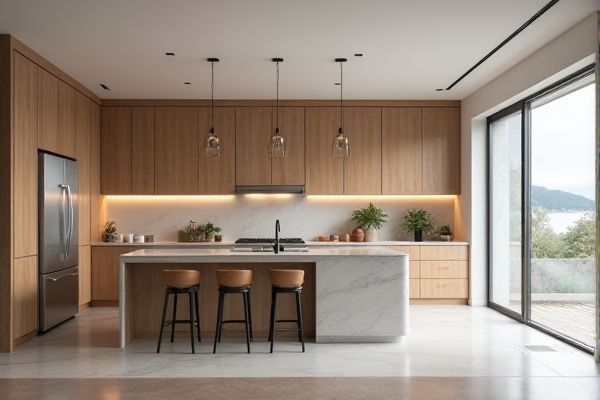
Frameless cabinets offer a sleek, modern look with more accessible storage space, while face-framed cabinets provide extra structural support and a classic aesthetic. Explore the full article to determine which style best suits your kitchen design and functional needs.
Table of Comparison
| Feature | Frameless Cabinets | Face-Framed Cabinets |
|---|---|---|
| Construction | No front frame; uses thicker side panels | Front frame attached to cabinet box |
| Interior Space | Maximized usable interior space | Reduced space due to frame overlap |
| Door Overlay | Full-overlay doors | Overlay or inset doors |
| Appearance | Sleek, modern, European style | Traditional, classic look |
| Durability | Less rigid, relies on thicker sides | More rigid and sturdy due to frame |
| Installation | Easier alignment, fewer parts | More complex due to frame alignment |
| Cost | Usually higher quality, can be pricier | Generally more affordable |
Introduction to Frameless and Face-Framed Cabinets
Frameless cabinets, also known as European-style, feature full-access storage with a sleek, modern appearance due to the absence of a face frame. Face-framed cabinets include a wooden frame around the front edges, adding structural stability and a classic, traditional look. Understanding these differences helps you choose the cabinet style that best fits your kitchen design and functionality needs.
Defining Frameless Cabinets
Frameless cabinets, also known as European-style cabinets, feature a full-overlay door design without a face frame, maximizing storage space and offering a sleek, modern look. These cabinets rely on thick side panels and robust hardware to maintain structural integrity and allow for wider shelves and easier access. Their construction allows for seamless installation of accessories like pull-out shelves and organizers, enhancing functionality and aesthetic appeal.
Understanding Face-Framed Cabinets
Face-framed cabinets feature a sturdy frame made from hardwood strips attached to the front edges of the cabinet box, providing extra support and durability. This frame creates defined edges and a classic, traditional look, enhancing the cabinet's structural stability and concealing the cabinet's plywood or particleboard box. Understanding the construction and aesthetic benefits of face-framed cabinets helps in choosing between the seamless, modern appeal of frameless designs versus the timeless strength and style of face-framed cabinetry.
Key Differences Between Frameless and Face-Framed Designs
Frameless cabinets feature full-access openings without a face frame, providing a modern, sleek look and maximizing interior space for storage. Face-framed cabinets have a front frame that reinforces structure and offers a classic appearance but slightly reduces access to the interior. Your choice depends on kitchen layout preferences, durability needs, and style, with frameless designs popular in European kitchens and face-framed cabinets favored in traditional setups.
Aesthetic Appeal: Style and Finish Comparisons
Frameless cabinets offer a sleek, modern aesthetic with clean lines and minimalist style, ideal for contemporary kitchen designs, while face-framed cabinets provide a classic, traditional look with visible frames that add depth and structure. The style and finish options for frameless cabinets often feature flat, slab doors that emphasize smooth surfaces and uniformity, contrasting with face-framed cabinets' raised or recessed panel doors that highlight craftsmanship and detail. Your choice between the two will affect the visual impact of your space, balancing modern simplicity against timeless elegance.
Storage Space and Functionality
Frameless cabinets offer increased storage space due to their full-access design, allowing easier organization and accommodation of larger items without obstruction from a face frame. Face-framed cabinets provide structural support and durability but reduce interior space slightly, which can limit storage capacity and accessibility. The functionality of frameless cabinets is enhanced by their modern construction, enabling seamless installation of adjustable shelves and pull-out drawers for optimized use.
Durability and Construction Quality
Frameless cabinets, also known as European-style, offer enhanced durability due to their thicker side panels and full-overlay doors that reduce wear on edges. Face-framed cabinets provide additional structural support with their frame construction, which can better resist warping over time. Your choice depends on whether you prioritize a modern, robust design or traditional strength and longevity in cabinet construction.
Installation Process and Complexity
Frameless cabinets feature a simple box design that allows for straightforward installation with fewer alignment challenges, often reducing labor time compared to face-framed cabinets. Face-framed cabinets require precise alignment of the frame with doors and drawers, increasing installation complexity and the need for specialized tools or skills. The increased rigidity of face-framed cabinets provides structural support but typically demands more detailed measurements and adjustments during installation.
Cost Factors: Price Comparison and Value
Frameless cabinets generally cost less due to reduced material use and simpler construction, offering a modern aesthetic at a lower price point compared to face-framed cabinets. Face-framed cabinets involve more labor and higher materials costs, leading to increased prices but potentially offering greater durability and classic appeal. Evaluating long-term value depends on design preferences, kitchen use, and budget constraints, with frameless cabinets excelling in cost efficiency and face-framed options often providing enhanced structural integrity.
Choosing the Right Cabinet Style for Your Space
Frameless cabinets offer a modern, sleek look with increased storage space due to their full-access design, making them ideal for contemporary kitchens or smaller areas where maximizing space is crucial. Face-framed cabinets provide a traditional aesthetic with added durability and structural support, often preferred in classic or rustic kitchen designs for their enhanced strength and customized appearance. Selecting between frameless and face-framed cabinets depends on your kitchen's style, storage needs, and the desired balance between modern efficiency and traditional craftsmanship.
 homyna.com
homyna.com